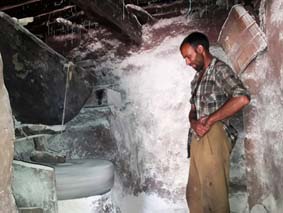news details |
|
|
| Gharat dying a slow but sure death | | `Being replaced by mills run by electricity' | |  Arun Jasrotia Arun Jasrotia
Early Times Report
Udhampur, Apr 29 : The centuries old water mills commonly known as Gharat are fast losing their sheen. Udhampur villages narrate the story of their slow but sure doom.
Gharats are water-powered grinding mills found in the whole of Sub- Himalayas and upper Shivaliks. The gharat is generally set up along the bank of a perennial stream close to the village. The water of the stream is diverted through a channel up to the site of the mill-house, which is generally constructed at a point where a waterfall of 2 to 6 meters is achieved from the channel. A long wooden chute consisting of an open channel made either of wooden planks or carved from a large tree trunk is narrowed down towards the lower end forming a nozzle. The force of the water let through the chute strikes the blades of the turbine in the mill-house and rotates the wheel, which in turn rotates the wooden shaft. The average power output of a gharat ranges from 1.0 KW to 1.5 KW and the grinding capacity ranges from 4-8 kg flour per hour depending on water availability and types of grains. Though these are owned and managed by individuals, they are considered to be the common property of the entire village. Traditionally, the villagers contributed labour to the gharat owner at the time of its installation or during repairs in return for which their grains were ground for free for social and religious ceremonies.
But unfortunately now a days the mechanisms that use running water to grind wheat, rice and maize and also occasionally to extract oil, have been replaced by electricity run mills.
That they are environmentally friendly and green has been forgotten, and the new generation does not know much about these primitive e machines.
However with the passage of time, the Gharats are fast dying and losing the ground to Atta Chakkis powered by electricity.
Now a days each Atta Chakki license issued by District authorities strangles the gharats.
The large-scale deforestation, various road works in villages and lifting of water for drinking purpose has robbed the streams of the assured water flow for running of these Gharats.
Until a few years ago, most villages in Udhampur districts housed 3 or 4 gharats, many on the same stream. Now, it is only the older generation who speaks about them; the younger lot do not even recall seeing any.
Madan , who has been grinding grains in Gharats for the last 30 years in Kothi Bari Panchari area of district Udhampur said: "It is difficult to make ends meet. No one has the time and patience for this atta even though it stays fresh for longer and is much tastier. We lost our livelihood and are totally dependent upon farming and occasional labour." |
|
|
|
|
|
|
|
|
|
|
|
|
| |
| |
|
|
|
|
 |
|
|
|
|
STOCK UPDATE |
|
|
 |
| BSE
Sensex |
 |
| NSE
Nifty |
|
|
| |
CRICKET UPDATE |
|
|
|
|
|
| |
| |
|
|
| |
|
|
|
|
| |
|
|
|
|
|
|
|
|
|
|
|
|
|
